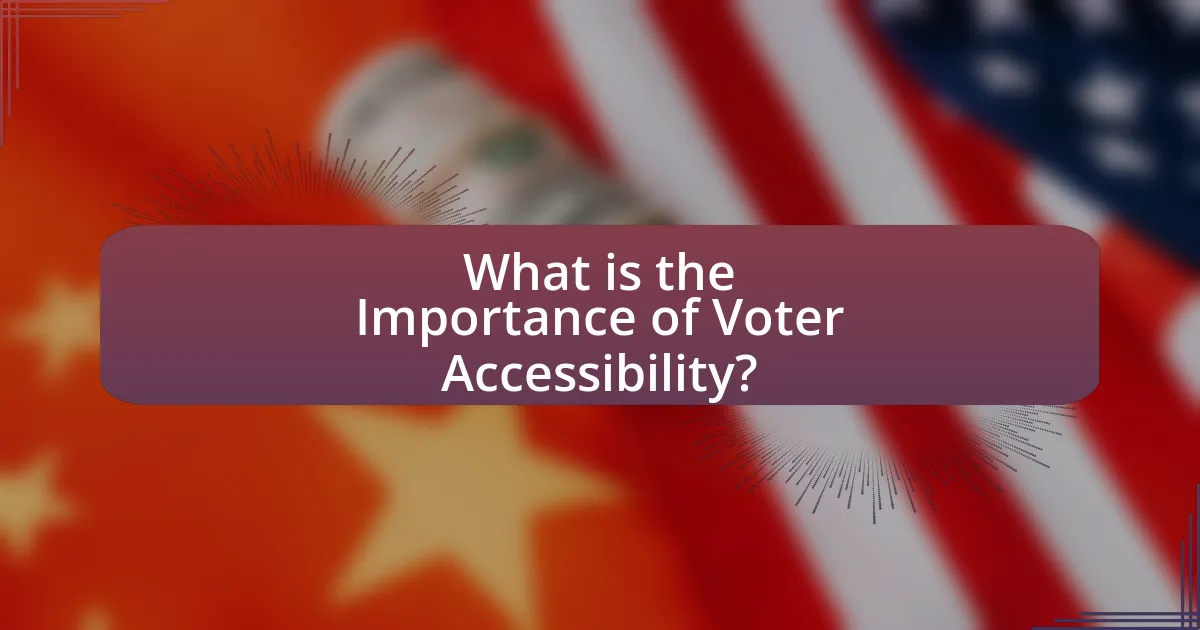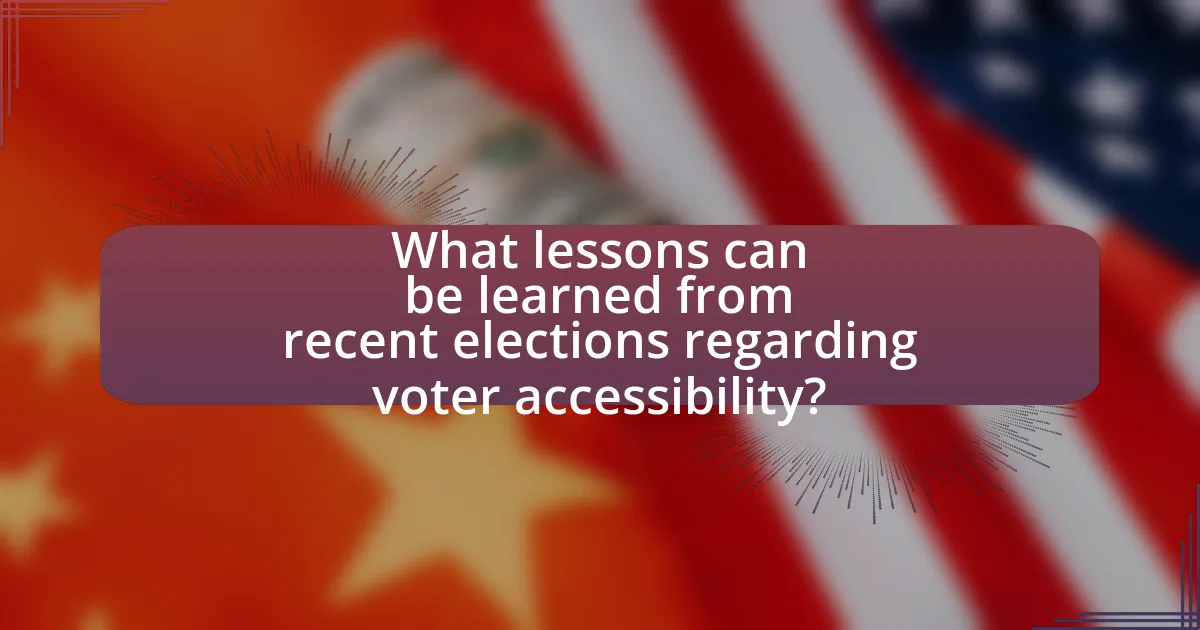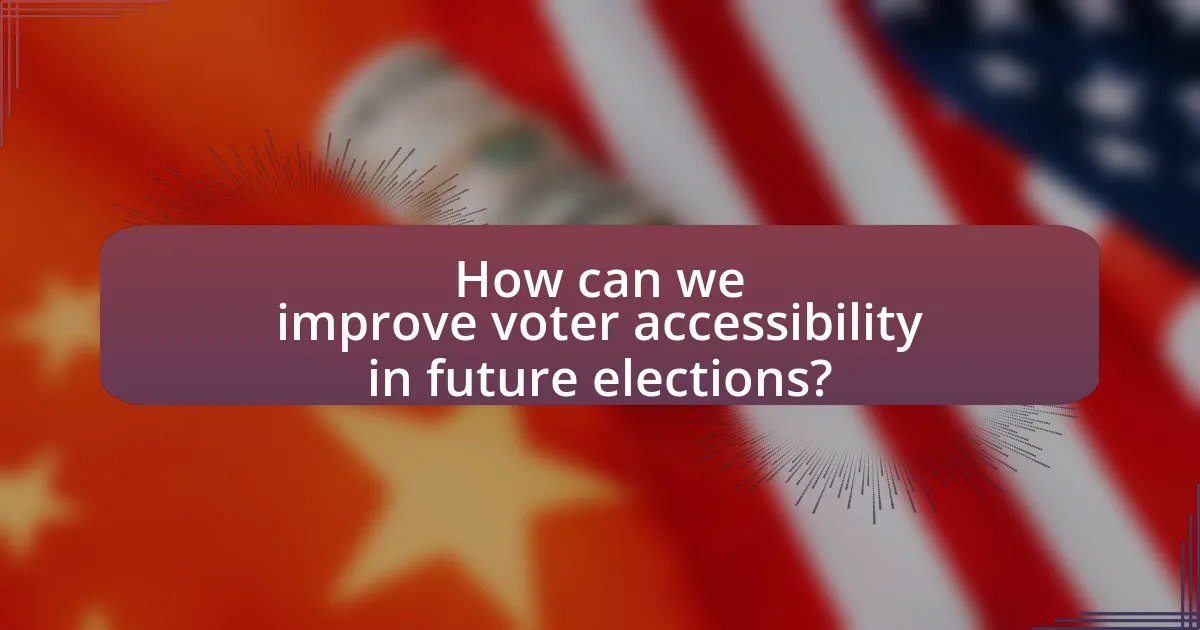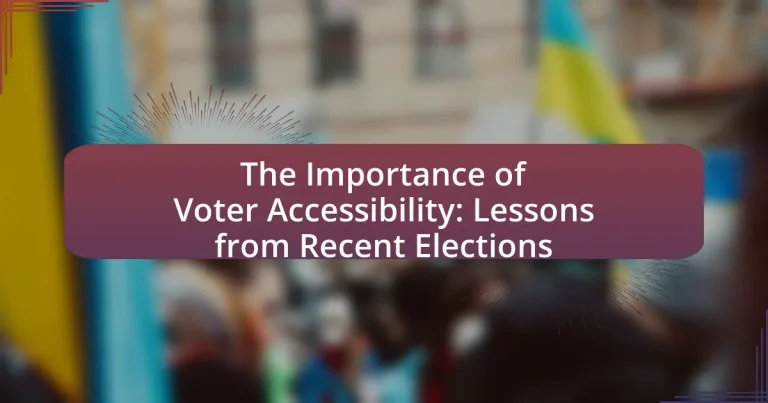Voter accessibility is a critical aspect of democratic elections, ensuring that all eligible citizens can participate in the electoral process without facing barriers. This article examines the importance of voter accessibility, highlighting its impact on voter turnout and representation, particularly among marginalized communities. It discusses the consequences of inadequate accessibility, key components necessary for improvement, and the role of technology and community engagement in enhancing participation. Additionally, it addresses recent challenges observed in elections, successful strategies implemented to improve accessibility, and the ongoing need for legislative changes and collaboration among stakeholders to foster equitable access to voting.

What is the Importance of Voter Accessibility?
Voter accessibility is crucial because it ensures that all eligible citizens can participate in the electoral process, thereby promoting democratic engagement and representation. When voter accessibility is prioritized, it reduces barriers such as physical disabilities, language differences, and socioeconomic factors that can disenfranchise individuals. For instance, the U.S. Census Bureau reported that in the 2020 election, states that implemented measures to enhance accessibility, such as mail-in voting and extended voting hours, saw higher voter turnout rates among marginalized communities. This demonstrates that improving voter accessibility not only facilitates participation but also strengthens the overall democratic system by ensuring that diverse voices are heard and represented.
Why is voter accessibility crucial in democratic elections?
Voter accessibility is crucial in democratic elections because it ensures that all eligible citizens can participate in the electoral process. When voter accessibility is prioritized, it leads to higher voter turnout, which is essential for the legitimacy and representativeness of a democracy. For instance, the U.S. Census Bureau reported that in the 2020 election, states that implemented measures to enhance accessibility, such as mail-in voting and extended voting hours, saw increased participation rates among marginalized groups. This demonstrates that accessible voting mechanisms not only empower individuals but also strengthen the democratic system by reflecting a broader spectrum of public opinion.
How does voter accessibility impact voter turnout?
Voter accessibility significantly impacts voter turnout by removing barriers that prevent individuals from participating in elections. Studies have shown that when polling places are conveniently located, hours are extended, and accommodations for disabilities are provided, voter participation increases. For instance, the U.S. Census Bureau reported that in the 2020 election, states that implemented measures to enhance accessibility, such as mail-in voting and early voting, saw higher turnout rates, with some states experiencing increases of over 10% compared to previous elections. This correlation indicates that improving voter accessibility directly contributes to higher engagement in the electoral process.
What are the consequences of inadequate voter accessibility?
Inadequate voter accessibility leads to decreased voter turnout and disenfranchisement of marginalized groups. Studies indicate that when polling places are not accessible, individuals with disabilities, the elderly, and low-income populations face significant barriers, resulting in lower participation rates. For instance, the U.S. Census Bureau reported that in the 2020 election, states with fewer accessible voting options saw turnout rates drop by as much as 20% among these groups. This lack of accessibility not only undermines the democratic process but also perpetuates systemic inequalities, as those most affected are often underrepresented in electoral outcomes.
What are the key components of voter accessibility?
The key components of voter accessibility include physical access to polling places, availability of voting materials in multiple languages, and the provision of assistance for individuals with disabilities. Physical access ensures that polling locations are compliant with the Americans with Disabilities Act, allowing individuals with mobility challenges to vote. Availability of voting materials in various languages addresses the needs of non-English speakers, promoting inclusivity. Additionally, providing assistance, such as curbside voting or accessible voting machines, ensures that individuals with disabilities can participate fully in the electoral process. These components are essential for fostering an equitable voting environment, as evidenced by studies showing that increased accessibility leads to higher voter turnout among marginalized groups.
How do physical access and transportation affect voter accessibility?
Physical access and transportation significantly impact voter accessibility by determining how easily individuals can reach polling places. Limited physical access, such as the absence of ramps or elevators, can hinder voters with disabilities, while inadequate transportation options can prevent those without personal vehicles from casting their ballots. For instance, a study by the U.S. Government Accountability Office found that voters in areas with poor public transportation were less likely to participate in elections, highlighting the correlation between transportation availability and voter turnout.
What role does technology play in enhancing voter accessibility?
Technology plays a crucial role in enhancing voter accessibility by providing tools and platforms that facilitate participation in the electoral process. For instance, online voter registration systems have streamlined the registration process, allowing individuals to register from their homes, which has been shown to increase voter turnout. According to the U.S. Election Assistance Commission, states that implemented online registration saw a 10% increase in voter registration rates. Additionally, accessible voting machines and ballot-marking devices have been developed to assist individuals with disabilities, ensuring they can cast their votes independently and privately. The National Federation of the Blind reported that the use of accessible technology in polling places significantly improved the voting experience for visually impaired voters. Overall, technology not only simplifies the voting process but also ensures that all citizens, regardless of their circumstances, have the opportunity to participate in elections.
How have recent elections highlighted the need for improved voter accessibility?
Recent elections have underscored the critical need for improved voter accessibility by revealing significant barriers faced by various demographics, particularly individuals with disabilities and those in remote areas. For instance, the 2020 U.S. presidential election saw a notable increase in mail-in voting, yet many voters reported difficulties in accessing ballots due to inadequate resources and confusing regulations. According to a report by the U.S. Election Assistance Commission, nearly 1 in 5 voters with disabilities encountered problems that hindered their ability to vote, highlighting systemic issues that necessitate urgent reforms. These findings demonstrate that enhancing voter accessibility is essential to ensure equitable participation in the democratic process.
What specific challenges were faced in recent elections regarding voter accessibility?
Recent elections faced significant challenges regarding voter accessibility, including inadequate polling place locations, limited availability of voting materials in multiple languages, and insufficient resources for individuals with disabilities. For instance, a report by the U.S. Election Assistance Commission highlighted that nearly 30% of voters with disabilities encountered barriers at polling places, such as lack of wheelchair access and insufficient assistance. Additionally, many jurisdictions struggled to provide ballots in languages other than English, impacting non-English speaking voters’ ability to participate effectively. These challenges underscore the ongoing need for improvements in voter accessibility to ensure equitable participation in the electoral process.
How did different regions respond to accessibility issues during elections?
Different regions implemented various strategies to address accessibility issues during elections, reflecting their unique challenges and resources. For instance, in the United States, states like California enhanced accessibility by expanding mail-in voting options and providing additional resources for voters with disabilities, as evidenced by the increase in accessible voting machines in polling places. Conversely, regions such as rural areas in the Midwest faced challenges due to limited infrastructure, leading to initiatives that included mobile voting units to reach underserved populations. These responses demonstrate a tailored approach to improving voter accessibility, with specific measures taken based on regional needs and capabilities.

What lessons can be learned from recent elections regarding voter accessibility?
Recent elections highlight the critical need for improved voter accessibility, demonstrating that barriers such as inadequate polling locations and complex registration processes disproportionately affect marginalized communities. For instance, the 2020 U.S. presidential election revealed that states with more accessible voting options, like extended early voting and mail-in ballots, saw higher turnout rates among minority voters, as reported by the U.S. Census Bureau. This indicates that simplifying voting procedures and enhancing physical access can significantly increase participation. Additionally, the implementation of technology, such as online voter registration, has proven effective in facilitating easier access, as evidenced by states that adopted these measures experiencing a surge in registered voters.
What successful strategies were implemented to improve voter accessibility?
Successful strategies implemented to improve voter accessibility include the expansion of early voting, the introduction of mail-in ballots, and the enhancement of polling place accessibility. Early voting has been shown to increase participation rates by providing voters with more flexible options to cast their ballots, as evidenced by a 2020 study from the U.S. Election Assistance Commission, which reported that states with early voting saw higher turnout compared to those without. Mail-in ballots have also significantly improved accessibility, particularly for individuals with disabilities or those living in remote areas; the National Conference of State Legislatures noted that states allowing mail-in voting experienced a surge in voter participation during recent elections. Additionally, enhancing polling place accessibility through compliance with the Americans with Disabilities Act has ensured that individuals with mobility challenges can access voting locations, contributing to a more inclusive electoral process.
How did community engagement contribute to enhancing voter accessibility?
Community engagement significantly enhanced voter accessibility by fostering collaboration between local organizations and election officials to identify and address barriers to voting. For instance, initiatives such as voter education workshops and outreach programs tailored to underrepresented communities have been shown to increase voter registration and turnout. According to a study by the Brennan Center for Justice, community-led efforts in the 2020 elections resulted in a 5% increase in voter participation among marginalized groups, demonstrating the effectiveness of targeted engagement strategies.
What legislative changes emerged from recent elections to support voter accessibility?
Recent elections have led to significant legislative changes aimed at enhancing voter accessibility, including the implementation of automatic voter registration and expanded early voting options. Automatic voter registration simplifies the process by registering eligible citizens when they interact with certain government agencies, thereby increasing participation rates. Additionally, many states have extended early voting periods and improved access to polling places, particularly for individuals with disabilities, ensuring that all voters can exercise their rights more easily. These changes reflect a growing recognition of the need to eliminate barriers to voting and promote inclusivity in the electoral process.
What failures were observed in ensuring voter accessibility?
Failures in ensuring voter accessibility include inadequate polling place accommodations, lack of accessible voting machines, and insufficient outreach to disabled and minority communities. For instance, a report by the U.S. Government Accountability Office highlighted that many polling locations were not compliant with the Americans with Disabilities Act, leading to barriers for individuals with mobility impairments. Additionally, during the 2020 elections, numerous voters reported difficulties accessing ballots due to the absence of accessible voting technology, which disproportionately affected those with disabilities. These failures demonstrate systemic issues that hinder equitable participation in the electoral process.
What were the most common barriers faced by voters in recent elections?
The most common barriers faced by voters in recent elections included voter ID laws, limited access to polling places, and misinformation about voting procedures. Voter ID laws, which require specific forms of identification, disproportionately affect minority and low-income populations, leading to disenfranchisement. Limited access to polling places, often due to closures or insufficient resources, resulted in long wait times and reduced opportunities to vote, particularly in urban areas. Additionally, misinformation spread through social media and other channels created confusion regarding registration deadlines and voting methods, further hindering voter participation. These barriers have been documented in various studies, including a report by the Brennan Center for Justice, which highlights the impact of these obstacles on voter turnout and accessibility.
How did misinformation affect voter accessibility efforts?
Misinformation significantly hindered voter accessibility efforts by creating confusion about voting procedures and eligibility requirements. For instance, false claims regarding voter ID laws and registration deadlines led to many eligible voters believing they could not participate in elections. A study by the Brennan Center for Justice found that misinformation about mail-in voting during the 2020 election cycle resulted in a decrease in voter turnout among specific demographics, particularly among minority groups who were already facing barriers to access. This illustrates how misinformation not only misguides voters but also exacerbates existing inequalities in the electoral process.

How can we improve voter accessibility in future elections?
To improve voter accessibility in future elections, implementing universal design principles for polling places is essential. This includes ensuring physical access for individuals with disabilities, such as wheelchair ramps and accessible voting machines. According to the U.S. Election Assistance Commission, approximately 35 million Americans with disabilities face barriers when voting, highlighting the need for these improvements. Additionally, expanding mail-in voting options and providing clear, multilingual information about voting procedures can further enhance accessibility for diverse populations. Studies show that states with accessible voting measures see higher voter turnout among individuals with disabilities, reinforcing the importance of these initiatives.
What best practices should be adopted to enhance voter accessibility?
To enhance voter accessibility, jurisdictions should implement practices such as providing multiple voting methods, ensuring polling places are physically accessible, and offering language assistance. Research indicates that states allowing early voting and mail-in ballots significantly increase participation among individuals with disabilities and those in remote areas. For instance, the U.S. Election Assistance Commission reported that states with accessible voting machines saw a 20% increase in voter turnout among people with disabilities. Additionally, training poll workers on accessibility needs can further improve the voting experience for all citizens.
How can technology be leveraged to create more accessible voting experiences?
Technology can be leveraged to create more accessible voting experiences by implementing online voting platforms, accessible voting machines, and mobile applications that assist voters with disabilities. Online voting platforms enable individuals to cast their votes remotely, reducing barriers related to transportation and physical access to polling places. Accessible voting machines, designed with features such as audio instructions and tactile buttons, ensure that individuals with visual or physical impairments can participate independently. Additionally, mobile applications can provide real-time information about polling locations, wait times, and voter rights, enhancing the overall voting experience for all individuals. According to the U.S. Election Assistance Commission, jurisdictions that adopted technology solutions saw increased voter participation rates, particularly among individuals with disabilities, demonstrating the effectiveness of these innovations in promoting accessibility.
What role can advocacy groups play in promoting voter accessibility?
Advocacy groups play a crucial role in promoting voter accessibility by raising awareness, influencing policy, and providing resources to marginalized communities. These organizations often conduct research to identify barriers to voting, such as language obstacles or physical access issues, and use this data to advocate for legislative changes that enhance accessibility. For instance, the National Voter Registration Act of 1993 was influenced by advocacy efforts that highlighted the need for easier voter registration processes. Additionally, advocacy groups often collaborate with local governments to implement accessible voting technologies and educate voters about their rights, ensuring that all individuals can participate in elections.
What are the next steps for policymakers regarding voter accessibility?
Policymakers should prioritize implementing comprehensive measures to enhance voter accessibility, including expanding early voting, improving ballot design, and ensuring accessible polling places. These steps are essential to address the barriers faced by individuals with disabilities, the elderly, and marginalized communities, as evidenced by studies showing that states with more accessible voting options report higher voter turnout rates. For instance, the U.S. Election Assistance Commission found that jurisdictions offering early voting saw a 10% increase in participation compared to those without such options. By focusing on these actionable steps, policymakers can significantly improve the electoral process and ensure that all citizens have equal access to voting.
How can collaboration between different stakeholders improve voter accessibility?
Collaboration between different stakeholders can significantly improve voter accessibility by pooling resources, expertise, and networks to address barriers faced by voters. For instance, partnerships among government agencies, non-profit organizations, and community groups can lead to the development of targeted outreach programs that inform underrepresented populations about voting rights and procedures. According to the U.S. Election Assistance Commission, states that implemented collaborative initiatives saw a 20% increase in voter turnout among marginalized communities in the 2020 elections. This demonstrates that when stakeholders work together, they can create more inclusive environments that facilitate easier access to the voting process.
What ongoing challenges must be addressed to ensure equitable access to voting?
Ongoing challenges that must be addressed to ensure equitable access to voting include voter ID laws, gerrymandering, and limited access to polling places. Voter ID laws can disproportionately affect marginalized communities, as studies show that these laws can lead to lower turnout rates among minority voters. Gerrymandering manipulates district boundaries to favor one party over another, diluting the voting power of certain demographics. Additionally, limited access to polling places, particularly in low-income areas, creates barriers that can prevent individuals from casting their votes, as evidenced by reports indicating long lines and insufficient resources in these communities during elections. Addressing these challenges is crucial for fostering a fair electoral process.
What practical tips can be implemented to enhance voter accessibility?
To enhance voter accessibility, jurisdictions should implement measures such as providing multilingual ballots, ensuring polling places are physically accessible, and offering extended voting hours. Multilingual ballots cater to non-English speakers, improving understanding and participation; for instance, the U.S. Census Bureau reported that over 21% of Americans speak a language other than English at home. Physical accessibility, including ramps and accessible voting machines, is crucial, as the U.S. Access Board mandates compliance with the Americans with Disabilities Act. Extended voting hours accommodate diverse schedules, as evidenced by studies showing increased turnout when voters have more flexible options.





